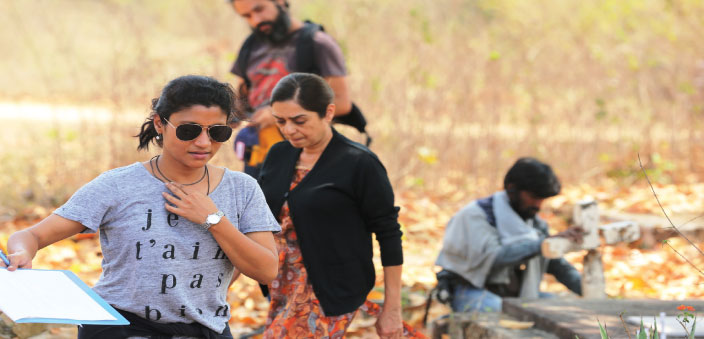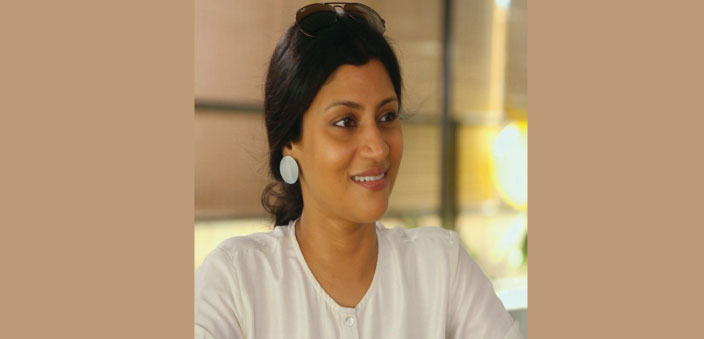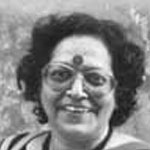What is A Death in the Ganj all about?
The place setting is McCluskieganj. Set in 1979, it is a coming-of-age story of a gangly, awkward, 23-year-old Shutu (Shyamal Chatterjee). He uses a family road trip to McCluskiegunj, an old, Anglo-Indian town, as an escape from his failed semester. The story is set within seven days of the last week of the year ending on New Year’s Day. The near-perfect family story has something amiss. It is based on a true story, but of course, I have embroidered it with a lot of fiction and more characters, to make a full-length film.
But we are told it is a small-budget film. Is that right?
Yes, you are right. It is a crowd-funded film which means that lots of my friends have come together to make this film possible. It is truly difficult to find a producer willing to put in money in this kind of a film, because it is not really a mainstream film. I am deeply indebted to Raagi Bhatnagar, Ashish Bhatnagar, Abhishek Choubey who directed Udta Punjab, and Honey Trehan who is a casting director for many films. We could not afford expensive stars or a lavish mounting, with the shoe-string budget we were working on. They are my friends and they all liked my screenplay. Thankfully, the film has turned out to be a sleeper hit, meaning that it is picking up slowly in the theatres, and critics too have liked it a lot. It was released on June 2, simultaneously in Kolkata, Bengaluru and Delhi.

How do you react to the Best Director Award for this film at the New York Film Festival?
It was thrilling because I was not expecting it at all. I also won the Best Actress Award for my acting in Lipstick Under My Burkha which went into a lot of censor trouble, but is finally releasing. It had its Indian premiere at MAMI Fest last year, and at the Toronto International Film Festival internationally. While deciding to make a film and during the process of making it, these things do not bother me at all, because I am totally focussed on my film. The response is not in my control, so my concentration is on things that are under my control.
Do you think that all the pre-release attention the film drew would affect the market of the film when released?
Not really, because I am concerned about the quality of the film which does not change either by the accolades or the brickbats it draws. It will bag awards in some festivals and none in other festivals. All I can say is that it is not a bad film. It is different, true, and quite unusual, but that is about it.
You have acted in Bengali, Hindi and English films and have a successful career. Did you think about direction at any time during this phase?
Not really. After delivering my little boy, my work had slowed down a bit. My flat was being renovated at that time, so I went to live with my father in Delhi for two months. We discussed a short story my father had written many years ago. I had heard the story from him as a child when we would visit McCluskieganj for holidays, as my paternal grandparents had a house there. But this time, when I read it again and discussed it with him, I felt it had scope for a lot of development to be made into a full-length feature film. The thought remained and kept haunting me even after I came back to Mumbai. That is how the script was born for A Death in the Ganj.
Tell us a bit more about this place, because very few people have even heard about it.
McCluskiegunj is a small town in Jharkhand, about 70 Km from Ranchi. It was the brainchild of Ernest Timothy McCluskie who created this homeland of members of the Anglo-Indian community. It is roughly an eight-hour drive from Kolkata. Between the 1930s and ‘40s, scores of Anglo-Indians from all parts of the Indian sub-continent came as settlers to this remote location that was once called Lapra, in the erstwhile state of Bihar, now in Jharkhand. I felt it would suit my story and would also be economical as we were making the film on a shoe-string budget, and we could shoot at a single stretch. As a small girl, I had lots of fun with my father narrating stories to me. Remember we did not have Internet or any other form of entertainment at the time, no cell phones, no What’sApp, nothing. But there were wonderful family reunions and lovely get-togethers, and lots of fun.

Some of this I have tried to bring into my film. But slowly, the fun and frolic faded, because the younger generation migrated to other places and the houses became empty. Today, it is a deserted place with very few senior citizens still pulling on. There are hostels and boarding houses for students who come to study here. But that is about all.
Did you miss acting during this process of direction?
Not at all. I have been observing and also working with my mother when she was directing. So, I am familiar with her work as director. For me, direction was a new high. I did not have to go through look tests, costume trials, workshops and an overload of make-up and all that goes with it. It was a thoroughly liberating experience, minus the mandatory baggage I must carry as an actress. It was very fulfilling in a different way.
Are you as disciplined and punctual and pre-planned like your mother as director?
Let me tell you that my directorial work has been deeply influenced by my mother’s way of working, and the tight budget forced me to plan much in advance than we needed to. Everything was detailed in terms of shot-breaks, framing of shots, dialogue, all of which were done much in advance. We had already done enough readings and had the time and space to thrash it out too. It is a small-budget film and since we were ready to shoot, the question of improvisation did not arise at all.
You have featured a mixed cast of veterans like Tanuja and Om Puri, contemporary actors like Ranvir Shorey and relative newcomers in the roles of the younger characters. Was it difficult?
No, because the young actors are all friends and we worked for so long that they internalised everything in terms of acting. The late Om Puri and Tanuja aunty have watched me grow up, and were extremely cooperative right through. In fact, for me, it was a wonderful learning experience.
Was this directorial venture a challenge for you?
Of course, it was a very big challenge. The biggest challenge was to recreate the period – 1979 – which is not exactly a ‘period’ film but a film that is placed in the past. At that time, you had to go to the local post office to make a telephone or trunk call. Letters would be handwritten on inland letters and bordered envelopes.
Young, westernised men wore strange hair cuts, suits and jackets, even the glasses that Nandu, one of the character wears, the slow lifestyle of the old couple, even the old blue Ambassador car the young family drive from Calcutta to visit Nandu’s parents. I must thank my entire cast and crew for making it possible to wrap up the shoot in six weeks.


 [/column]
[/column]